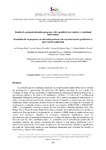Mostrar o rexistro simple do ítem
Results of a Postural Education Program, With a Gamified Intervention vs Traditional Intervention
| dc.contributor.author | Serrano Durá, José | |
| dc.contributor.author | Cabrera González, Adrián | |
| dc.contributor.author | Rodríguez-Negro, Josune | |
| dc.contributor.author | Monleón García, Cristina | |
| dc.date.accessioned | 2022-03-21T14:22:53Z | |
| dc.date.available | 2022-03-21T14:22:53Z | |
| dc.date.issued | 2021-05-01 | |
| dc.identifier.citation | Serrano-Durá, J., Cabrera González, A., Rodríguez-Negro, J., & Monleón García, C. (2021). Results of a postural education program, with a gamified intervention vs traditional intervention. Sportis. Scientific Technical Journal of School Sport, Physical Education and Psychomotricity, 7(2), 267-284. https://doi.org/10.17979/sportis.2021.7.2.7529 | es_ES |
| dc.identifier.issn | 2386-8333 | |
| dc.identifier.uri | http://hdl.handle.net/2183/30078 | |
| dc.description.abstract | [Resumen] La metodología de enseñanza adoptada por el profesorado puede influir en los niveles de participación y aprendizaje del alumnado. El objetivo principal de este estudio fue comparar el efecto de dos programas de intervención de educación postural en función de la metodología utilizada. Un total de 36 estudiantes (19 niñas y 17 niños) de 1º de Educación Secundaria Obligatoria participaron en el estudio. En el primer programa de intervención se aplicó una metodología gamificada, mientras que en el segundo se empleó una metodología tradicional. Ambos programas de intervención se llevaron a cabo a lo largo de 6 sesiones. Se analizaron los contenidos teóricos a través de dos cuestionarios (COSACUES y COSACUES-AEF) y la resistencia muscular a través de tres test físicos (Biering-Sørensen Test, Side Bridge Test y Prone Forearm Plank Test) antes y después de la intervención. Los niveles de motivación (Feeling Scale) y la percepción del esfuerzo (OMNI Scale) se midieron tras cada sesión. Los resultados obtenidos no mostraron diferencias significativas entre las metodologías, pero se encuentran diferencias en términos de género y tipo de metodología. Se demostró que las niñas asimilaban mejor los contenidos con la metodología gamificada. Se encuentra, además, una mayor percepción del esfuerzo y una mayor motivación con la intervención gamificada. Por lo tanto, la aplicación de intervenciones educativas gamificadas por parte del profesorado puede ser una estrategia interesante para aumentar los niveles de motivación y esfuerzo del alumnado. | es_ES |
| dc.description.abstract | [Abstract] The teaching methodology adopted by teachers can influence the levels of participation and learning of students. The main goal of this study was to compare the effect of two intervention programs of postural education according to the used methodology. A total of 36 students (19 girls and 17 boys) in the 1st year of high school participated in the study. In the first intervention program a gamified methodology was applied, while in the second one a traditional methodology was used. Both intervention programs were carried out along 6 sessions. Theoretical contents were analyzed through questionnaires (COSACUES and COSACUES-AEF) and muscular endurance through three physical tests (Biering-Sørensen Test, Side Bridge Test and Prone Forearm Plank Test) before and after the intervention. Motivation levels (Feeling Scale) and perception of effort (OMNI Scale) were measured after each session. The results obtained did not show significant differences between methodologies, but differences have been found in terms of gender and type of methodology. Girls were shown to assimilate better contents with the gamified methodology. There was also a greater perception of effort and greater motivation with the gamified intervention. Therefore, the application of gamified educational interventions by teachers can be an interesting strategy to increase the levels of motivation and effort of students. | es_ES |
| dc.language.iso | eng | es_ES |
| dc.publisher | Universidade da Coruña | es_ES |
| dc.relation.uri | https://doi.org/10.17979/sportis.2021.7.2.7529 | es_ES |
| dc.rights | Atribución-NoComercial-SinDerivadas 4.0 Internacional (CC BY-NC-ND 4.0) | es_ES |
| dc.rights.uri | https://creativecommons.org/licenses/by-nc-nd/4.0 | |
| dc.subject | Gamificación | es_ES |
| dc.subject | Motivación | es_ES |
| dc.subject | Educación física | es_ES |
| dc.subject | Educación para la salud | es_ES |
| dc.subject | Postura | es_ES |
| dc.subject | Gamification | es_ES |
| dc.subject | Motivation | es_ES |
| dc.subject | Physical education (secondary) | es_ES |
| dc.subject | Health education | es_ES |
| dc.subject | Posture | es_ES |
| dc.title | Results of a Postural Education Program, With a Gamified Intervention vs Traditional Intervention | es_ES |
| dc.title.alternative | Resultados de un programa de educación postural, con una intervención gamificada vs intervención tradicional | es_ES |
| dc.type | info:eu-repo/semantics/article | es_ES |
| dc.rights.access | info:eu-repo/semantics/openAccess | es_ES |
| dc.date.updated | 2022-03-21T13:31:21Z | |
| UDC.journalTitle | Sportis. Scientific Journal of School Sport, Physical Education and Psychomotricity | es_ES |
| UDC.volume | Vol. 7 | es_ES |
| UDC.issue | Núm. 2 | es_ES |
| UDC.startPage | 267 | es_ES |
| UDC.endPage | 284 | es_ES |
| dc.identifier.doi | 10.17979/sportis.2021.7.2.7529 |






